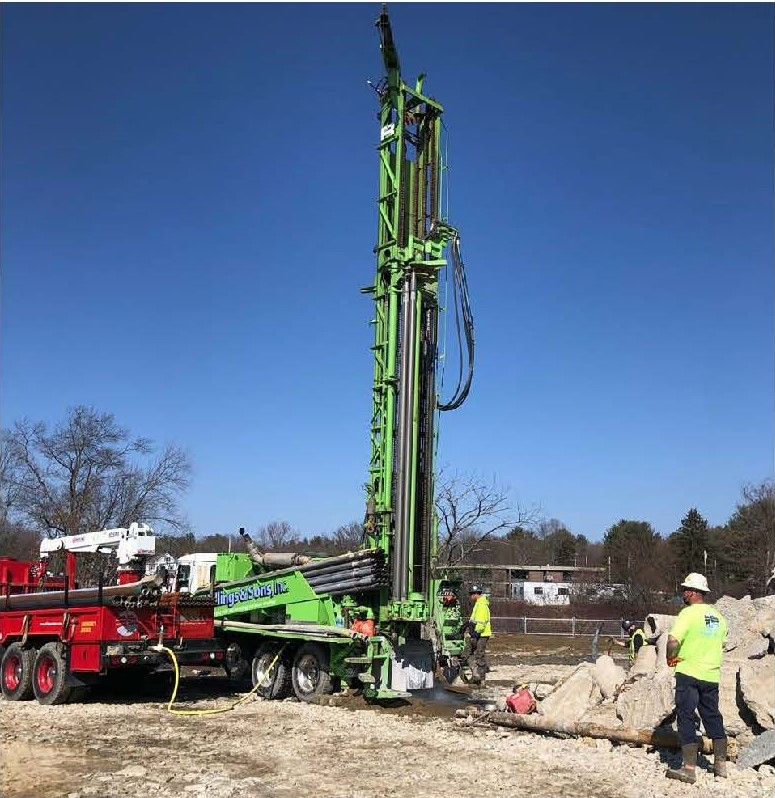Net Zero Aspects of School Project To Be Discussed March 29

Drilling one of 65 geothermal wells at the new Douglas & Gates Elementary School in Acton-Boxborough which is targeting Triple Net Zero (energy, water, and waste) and scheduled to open for fall 2022. Source: Massachusetts School Building Authority
DiNisco Design, the architecture firm for the elementary school building project, is expected to present a cost comparison of ground source vs. air source heating and cooling systems to the building committee’s Net Zero Subcommittee on Tuesday March 29. Which type of system is selected will partially determine the energy use of the all-electric building, the number of photovoltaic (PV) panels required to provide that electricity, and the project cost.
Ground source heating and cooling systems (also called geothermal) have higher upfront costs than air source systems (like VRF), but maintenance and operating costs are lower, and they are more energy efficient so require fewer PV panels to offset the energy needs. In a presentation by green design consultant Vamshee Gooje of Thornton Thomasetti on February 10, selecting a ground source system would have the greatest impact on reducing energy use.
The school building committee agreed to a target Energy Use Intensity (EUI) of 25 for the school project. (EUI is a measure of a building’s energy use per gross square foot of building per year. For comparison, a typical Massachusetts school building has an EUI of 58.) Reaching an EUI of 25 requires a multi-pronged approach: developing a well-insulated building envelope, reducing loads through daylighting/LED lighting/smart outlets/occupancy sensors, incorporating an energy-efficient heating and cooling system, and monitoring occupant use (operational hours/thermostat setpoints/electrical sub-metering).
DiNisco will also present a comparison of the benefits of each heating and cooling solution and a Life Cycle Cost Analysis showing the cost of the different systems over the expected 50-year life of the building, as well as the associated PV costs.
In addition to the systems cost, the ease of siting ground source wells at the Fort River and Wildwood sites is expected to factor into the decision about where the new school will be built. The designers have confirmed that both sites can accommodate a geothermal well field and solar PV array but to locate a well field on the Wildwood property they have indicated that the west parking lot, half of the north parking lot, and the entrance drive to the front of the school would likely have to be removed, which would complicate project phasing and construction. Costs of a temporary driveway, parking, and other implications have not yet been estimated. At Fort River, the location identified for a well field would affect the southern entrance driveway but the parking and functioning of the existing school would not be impacted.
A traffic study for the Wildwood site also indicated a possible need for a second driveway on Strong Street to mitigate queuing of vehicles. In comments made at the building committee meeting on March 25, project lead Tim Cooper said they are still exploring the viability of a second curb cut and driveway. To improve circulation, it would have to be far enough away from the existing entrance, and the steep grade up Strong Street from the school likely adds complication and cost. “We might get to a point where they’re not far enough away that it makes it worse, and we might get to a stage where the grade is too costly,” Cooper said.
The agenda for the Net Zero Subcommittee meeting includes a potential vote to recommend a heating and cooling system to the full committee, however chair Cathy Schoen acknowledged that understanding the implications is important and if they are not ready, they won’t take a vote.

A traffic study is insufficient: both sites need to be evaluated on the basis of overall transportation costs and comparative transportation energy usage – the latter will be a significant fraction of any “net-zero” savings and should not be ignored.